Analys
There is not much of a Mid-East risk premium to be seen

The Brent crude oil price has seen some good gains lately and mostly it has been explained with rising Mid-East tensions. But if we use the 3mth rolling implied crude oil volatility as a measure of such a ”risk premium” it is below the historical average since 2008 and has fallen back lately.

Amid all the media noise coming out of the Mid-East there are smaller bits and pieces of fundamentals which seems to drown out amid the noise. US crude stocks fell 9 million barrels last week and total US stocks fell 22.3 m b. The Chinese government has just announced that it will cut its reserve-requirement ratio within two weeks which is a positive for growth down the road. Global crude inventories dropped by 24 m b last week due to disruptions in the US, Libya and Kazakhstan according to Macquarie group. Crude time-spreads have moved back up to levels often seen in 2023 and oil product cracks have risen into the new year (except for 3.5%) which is often a sign of solid oil product demand and/or strained supply.
So as of yet, it doesn’t look like it is much a risk premium in oil due to the Mid-East tensions.
Brent crude 3mth forward ATM implied volatility. Falling back rather than rising. Should probably have spiked if there was real fear for Mid-East oil supply disruptions
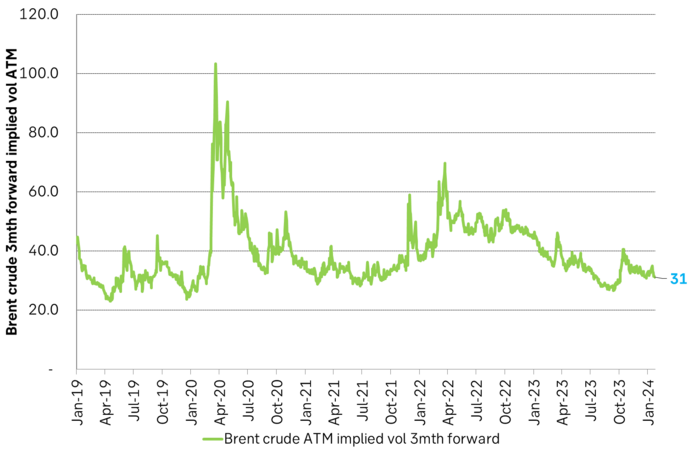
And sorting from low to high since Jan 2008 the current level of 31% is rather lukewarm:
Brent crude 3mth forward ATM implied volatility since Jan 2008. Not much fear currently.
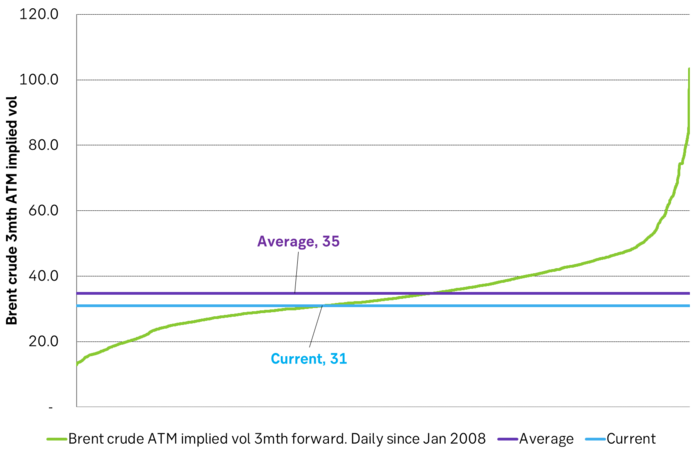
And speculators are not rushing in to buy oil in the hope of cashing in big time if we get disruption and a spike. Net long specs are instead at a bob-bob level with little rush from buyers.
Net-long specs in Brent crude and WTI with last data point as of Tuesday last week. Up from a recent low-point but still very muted level.
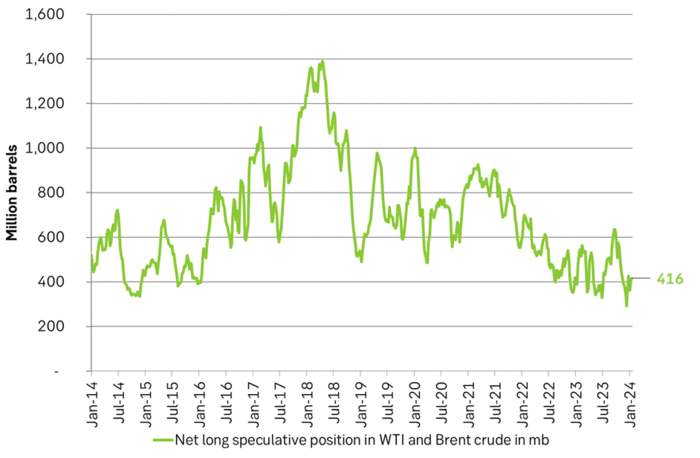
And looking at spec positions with a rolling 52 week ranking it is less than medium. Well on par with the level of backwardation:
52 week ranking of net long specs vs. Brent backwardation. Lukewarm with little sign of net long hording.
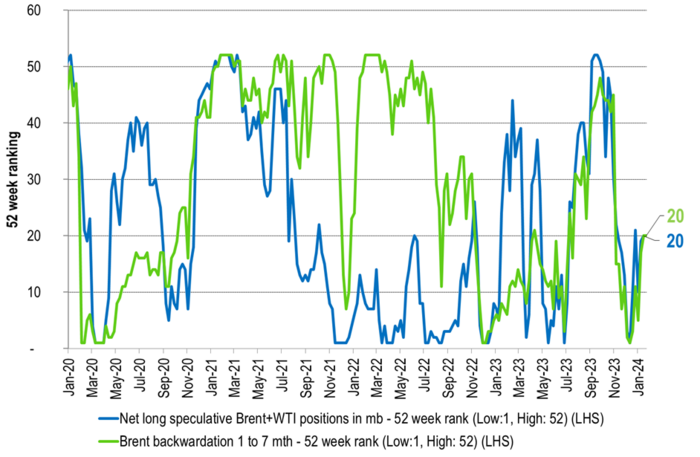
On the fundamental side however the product cracks have strengthened into the new year
Front-month ARA oil product cracks versus Brent crude have strengthened into the new year. Except for 3.5% cracks. But still a solid sign for oil product demand
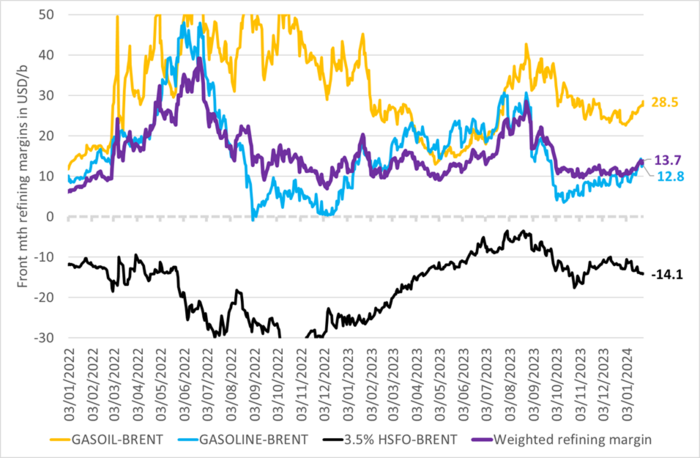
And time-spreads have recovered back from the slump just before Christmas. Again a normal sign of an oil market with fairly balanced to tight fundamentals.
Time spreads 1-3 mth for Brent, Dubai and WTI have all revived back to levels seen much of last year.
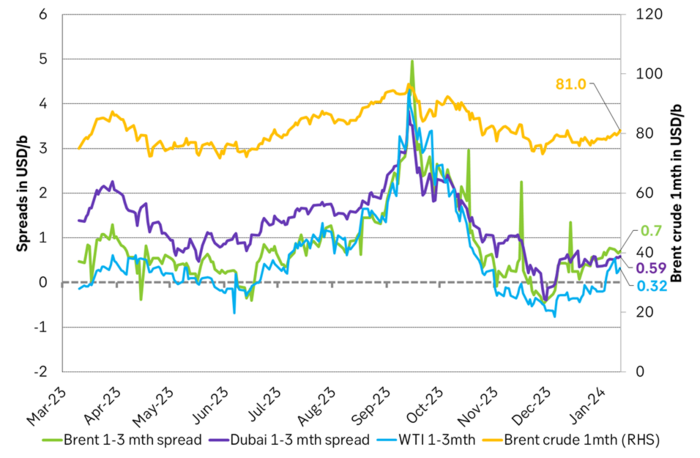
If we assume that changes in US oil inventories typically is a residual of the global oil market balance. If the world is in surplus then US inventories will typically rise and vise versus. Total US oil inventories have basically flat-lined in 2023 and still is. That indicates a fairly balanced global oil market.
Total US crude and product stocks incl. SPR
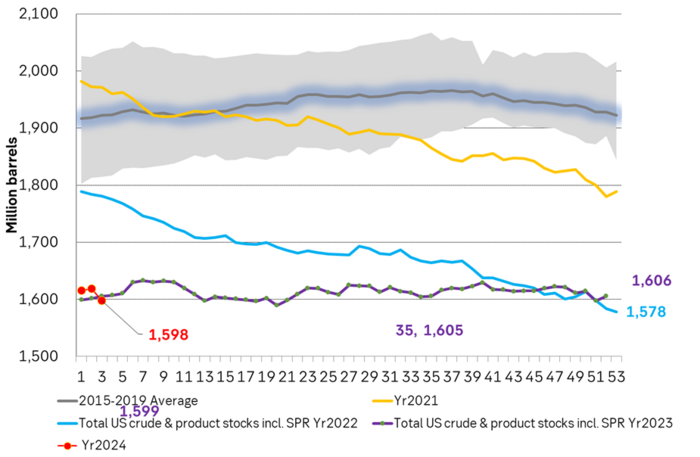
If we compare US total commercial crude and product stocks since Jan 2008 with inflation adjusted oil prices it indicates that current Brent crude oil price at USD 82/b is probably a quite fair price level.
The Brent crude oil price vs. US commercial crude and product stocks excl. SPR. Current oil price is well aligned with regression line.
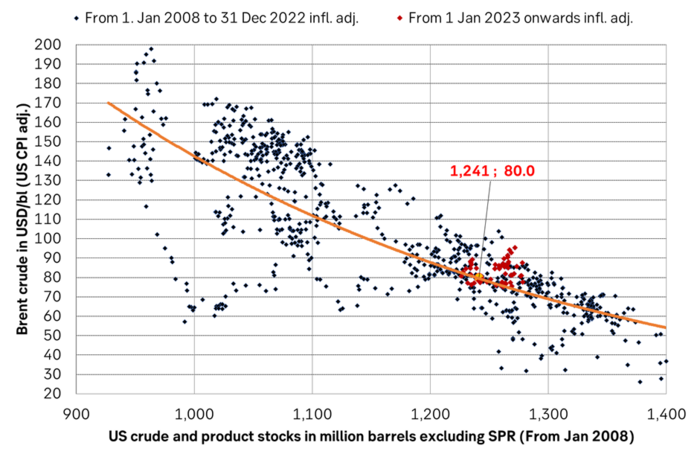
Analys
Brent edges higher as India–Russia oil trade draws U.S. ire and Powell takes the stage at Jackson Hole

Best price since early August. Brent crude gained 1.2% yesterday to settle at USD 67.67/b, the highest close since early August and the second day of gains. Prices traded to an intraday low of USD 66.74/b before closing up on the day. This morning Brent is ticking slightly higher at USD 67.76/b as the market steadies ahead of Fed Chair Jerome Powell’s Jackson Hole speech later today.

No Russia/Ukraine peace in sight and India getting heat from US over imports of Russian oil. Yesterday’s price action was driven by renewed geopolitical tension and steady underlying demand. Stalled ceasefire talks between Russia and Ukraine helped maintain a modest risk premium, while the spotlight turned to India’s continued imports of Russian crude. Trump sharply criticized New Delhi’s purchases, threatening higher tariffs and possible sanctions. His administration has already announced tariff hikes on Indian goods from 25% to 50% later this month. India has pushed back, defending its right to diversify crude sourcing and highlighting that it also buys oil from the U.S. Moscow meanwhile reaffirmed its commitment to supply India, deepening the impression that global energy flows are becoming increasingly politicized.
Holding steady this morning awaiting Powell’s address at Jackson Hall. This morning the main market focus is Powell’s address at Jackson Hole. It is set to be the key event for markets today, with traders parsing every word for signals on the Fed’s policy path. A September rate cut is still the base case but the odds have slipped from almost certainty earlier this month to around three-quarters. Sticky inflation data have tempered expectations, raising the stakes for Powell to strike the right balance between growth concerns and inflation risks. His tone will shape global risk sentiment into the weekend and will be closely watched for implications on the oil demand outlook.
For now, oil is holding steady with geopolitical frictions lending support and macro uncertainty keeping gains in check.
Oil market is starting to think and worry about next OPEC+ meeting on 7 September. While still a good two weeks to go, the next OPEC+ meeting on 7 September will be crucial for the oil market. After approving hefty production hikes in August and September, the question is now whether the group will also unwind the remaining 1.65 million bpd of voluntary cuts. Thereby completing the full phase-out of voluntary reductions well ahead of schedule. The decision will test OPEC+’s balancing act between volume-driven influence and price stability. The gathering on 7 September may give the clearest signal yet of whether the group will pause, pivot, or press ahead.
Analys
Brent sideways on sanctions and peace talks

Brent crude is currently trading around USD 66.2 per barrel, following a relatively tight session on Monday, where prices ranged between USD 65.3 and USD 66.8. While expectations of higher OPEC+ supply continue to weigh on sentiment, recent headlines have been dominated by geopolitics – particularly developments in Washington.

At the center is the White House meeting between Trump, Zelenskyy, and several key European leaders. During the meeting, Trump reportedly placed a direct call to Putin to discuss a potential bilateral sit-down between Putin and Zelenskyy, which several European officials have said could take place within two weeks.
While the Kremlin’s response remains vague, markets have interpreted this as a modestly positive signal, with both equities and global oil prices holding steady. Brent is marginally lower since yesterday’s close, while U.S. and Asian equity markets remain broadly flat.
Still, the political undertone is shifting, and markets may be underestimating the longer-term implications. According to the NY times, Putin has proposed a peace plan under which Russia would claim full control of the Donbas in exchange for dropping demands over Kherson and Zaporizhzhia – territories it has not yet seized.
Meanwhile, discussions around Ukraine’s long-term security framework are starting to take shape. Zelenskyy appeared encouraged by Trump’s openness to supporting a post-war security guarantee for Ukraine. While the exact terms remain unclear, U.S. special envoy Steve Witkoff stated that Putin had signaled willingness to allow Washington and its allies to offer Kyiv a NATO-style collective defense guarantee – a move that would significantly reshape the regional security landscape.
As diplomatic efforts gain momentum, markets are also beginning to assess the potential consequences of a partial or full rollback of U.S. sanctions on Russian energy. Any unwind would likely be gradual and uneven, especially if European allies resist or delay alignment. The U.S. could act unilaterally by loosening financial restrictions, granting Russian firms greater access to Western capital and services, and effectively neutralizing the price cap mechanism. However, the EU embargo on Russian crude and products remains a more immediate constraint on flows – particularly as it continues to tighten.
Even if the U.S. were to ease restrictions, Moscow would remain heavily reliant on buyers like India and China to absorb the majority of its crude exports, as European countries are unlikely to quickly re-engage in energy trade. That shift is already playing out. As India pulls back amid newly doubled U.S. tariffs – a response to its ongoing Russian oil purchases – Chinese refiners have stepped in.
So far in August, Chinese imports of Russia’s Urals crude – typically shipped from Baltic and Black Sea ports – have nearly doubled from the YTD average, with at least two tankers idling off Zhoushan and more reportedly en route (Kpler data). The uptick is driven by attractive pricing and the absence of direct U.S. trade penalties on China, which remains in a delicate tariff truce with Washington.
Indian refiners, by contrast, are notably more cautious – receiving offers but accepting few. The takeaway is clear: China is acting as the buyer of last resort for surplus Russian barrels, likely directing them into strategic storage. While this may temporarily cushion the effects of sanctions relief, it cannot fully offset the constraints imposed by Europe’s ongoing absence.
As a result, any meaningful boost to global supply from a rollback of U.S. sanctions on Russia may take longer to materialize than headlines suggest.
Analys
Crude inventories builds, diesel remain low

U.S. commercial crude inventories posted a 3-million-barrel build last week, according to the DOE, bringing total stocks to 426.7 million barrels – now 6% below the five-year seasonal average. The official figure came in above Tuesday’s API estimate of a 1.5-million-barrel increase.

Gasoline inventories fell by 0.8 million barrels, bringing levels roughly in line with the five-year norm. The composition was mixed, with finished gasoline stocks rising, while blending components declined.
Diesel inventories rose by 0.7 million barrels, broadly in line with the API’s earlier reading of a 0.3-million-barrel increase. Despite the weekly build, distillate stocks remain 15% below the five-year average, highlighting continued tightness in diesel supply.
Total commercial petroleum inventories (crude and products combined, excluding SPR) rose by 7.5 million barrels on the week, bringing total stocks to 1,267 million barrels. While inventories are improving, they remain below historical norms – especially in distillates, where the market remains structurally tight.
-

 Nyheter3 veckor sedan
Nyheter3 veckor sedanKopparpriset i fritt fall i USA efter att tullregler presenterats
-

 Nyheter3 veckor sedan
Nyheter3 veckor sedanLundin Gold rapporterar enastående borrresultat vid Fruta del Norte
-

 Nyheter3 veckor sedan
Nyheter3 veckor sedanStargate Norway, AI-datacenter på upp till 520 MW etableras i Narvik
-

 Nyheter4 veckor sedan
Nyheter4 veckor sedanMängden M1-pengar ökar kraftigt
-
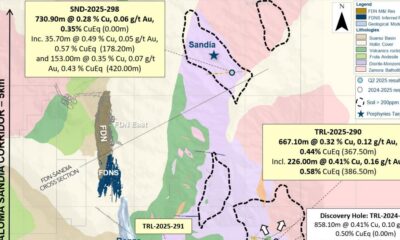
 Nyheter2 veckor sedan
Nyheter2 veckor sedanLundin Gold hittar ny koppar-guld-fyndighet vid Fruta del Norte-gruvan
-

 Nyheter2 veckor sedan
Nyheter2 veckor sedanGuld stiger till över 3500 USD på osäkerhet i världen
-

 Nyheter2 veckor sedan
Nyheter2 veckor sedanOmgående mångmiljardfiasko för Equinors satsning på Ørsted och vindkraft
-

 Nyheter3 veckor sedan
Nyheter3 veckor sedanAlkane Resources och Mandalay Resources har gått samman, aktör inom guld och antimon




